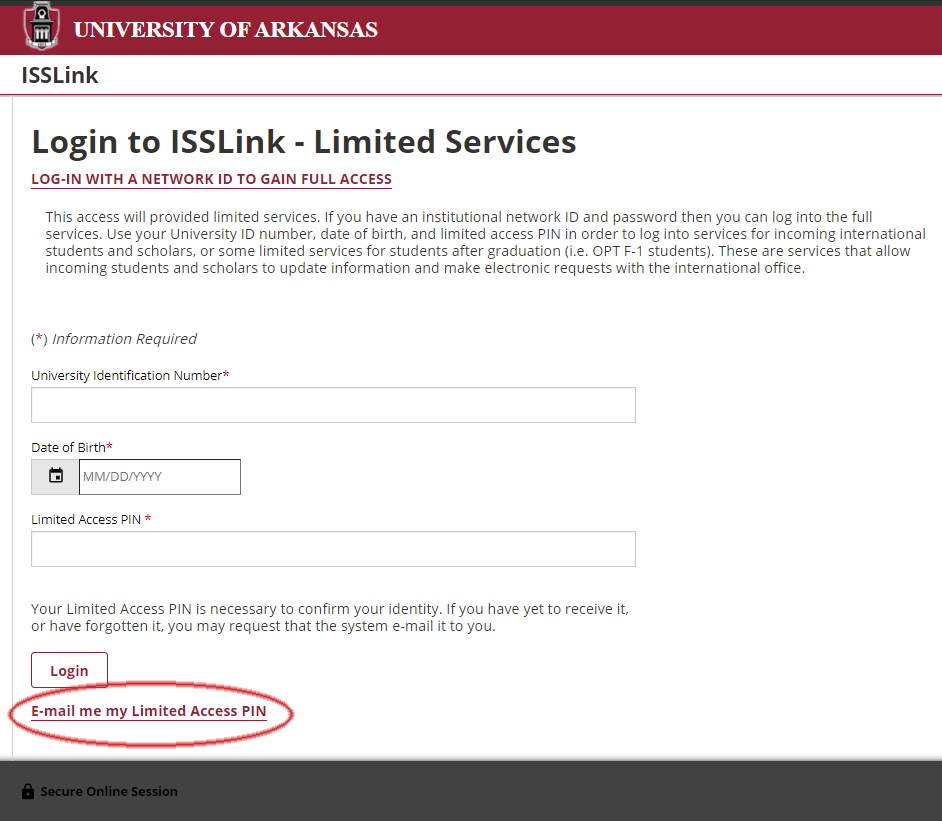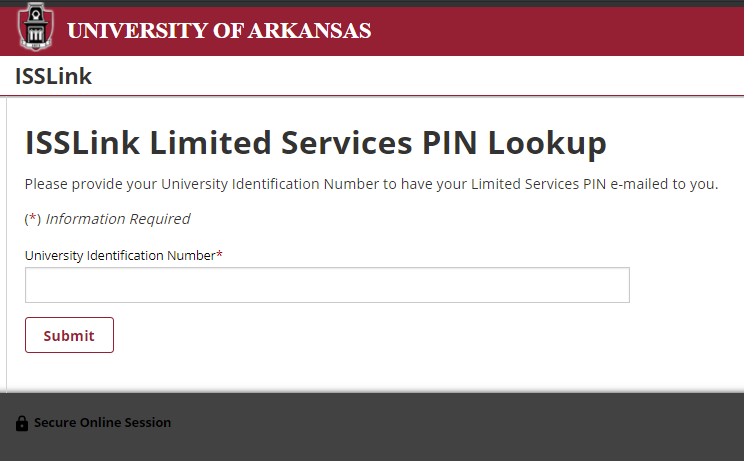International Students & Scholars (ISS)
104 Holcombe Hall
Fayetteville, AR 72701
Tel: 1-479-575-5003
Fax: 1-479-575-7084
iss@uark.edu
Introduction for Volunteers/Users Without an University I.D.
What is ISSLink?
ISSLink is a web browser based interface that allows users to electronically submit data to the International Students & Scholars Office’s online database. This eliminates the need for paper forms and ensures only accurate, relevant information is added to our database.
Among other purposes, ISSLink allows departments to submit applications for J-1 scholars and perform functions regarding H-1B employees, and it provides scholars the ability to access and update their information as needed.
Using ISSLink is easy and straightforward to submit eForms for review by ISS staff, and this documentation seeks to explain this paperless process to J-1 scholars and associated departments.
How to Get Started:
Requesting Limited Services Access:
For ISSLink users such as students without an I.D. or Volunteers with the iFriend’s Friendship Family or Campus Cousins programs, the first step in using ISSLink is to request access to Limited Services. If you are already an authorized ISSLink Limited Services user, skip to page 5.
- Navigate to http://isslink.uark.edu
- Click on “Limited Services” (See Figure 1)

Figure 1
- This will display the Limited Services log-in screen (See Figure 2)

Figure 2
- Enter your information provided to you by ISSLink via email. Once you are logged in proceed to step 8, Figure 5. If you do not have a pin, select “Email me my Limited Access PIN” as shown in Figure 3.

Figure 3
- You are now prompted to enter your University I.D. or Temporary I.D. that was sent to you before (Figure 4). If you do not have either of these, please email isslink@uark.edu to receive your Limited Access PIN.

Figure 4
[Tip] If there are any issues in trying to log in or that you need a temporary I.D., contact issLink@uark.edu or call (479) 575-5003.
Glossary of Terms
Dependent(s)
A spouse or unmarried child (under the age of 21) of the J-1 Exchange Visitor. The J-1 Exchange Visitor may be eligible to apply for J-2 visa so that dependent(s) may reside in the United States during the J-1 scholar's program.
DS-2019
The Form DS-2019 or “Certificate of Eligibility for Exchange Visitor (J-1) Status” is the basic document used in the administration of the exchange visitor program. This form permits a prospective exchange visitor to seek an interview at a U.S. embassy or consulate in order to obtain a J visa to enter the United States. The Form DS-2019 identifies the exchange visitor and their designated sponsor and provides a brief description of the exchange visitor’s program, including the start and end date, category of exchange, and an estimate of the cost of the exchange program.
ISSLink
The online database on which the International Students and Scholars Office maintains records of all past and present international applicants, students, scholars, and employees.
J-1
The Exchange Visitor (J) non-immigrant category is for individuals approved to participate in work and study based exchange visitor programs, which enable foreign nationals to visit the United States in order to experience life in the US. Before individuals can apply at a US embassy or consulate for a J visa, they must first apply, meet the requirements, and be accepted to an exchange visitor program through a designated sponsor organization. The Bureau of Consular Affairs has additional information about the Exchange Visitor (J) visa.
J-2
The J-2 is a nonimmigrant status which allows the dependents (spouses and unmarried children under 21) of J-1 student visa holders to enter into the US.
Non-immigrant status
Non-immigrant status is granted by USCIS when a foreign national arrives in the United States. The status matches the classification of visa the bearer has been granted by the U.S. Department of State, categorized according to the principal purpose for the visit. With few exceptions, while in the US, non-immigrants are restricted to the activity for which their visa was issued. Examples of non-immigrant statuses include J-1 (exchange student or scholar), F-1 (student), H-1B (temporary worker), etc.
SEVIS
SEVIS (Student and Exchange Visitor Information System) is an Internet-based system that provides tracking and monitoring functionality, with access to accurate and current information on nonimmigrant students (F and M visa) and exchange visitors (J visa), and their dependents (F-2, M-2, and J-2). SEVIS enables schools and program sponsors to transmit required information and event notifications, via the Internet, to the U.S. Department of Homeland Security and Department of State throughout a student's or exchange visitor's stay in the United States.
SEVIS fee
The U.S. Department of Homeland Security assesses a fee to supplement federal government expenses incurred in the maintenance and administration of the Student and Exchange Visitor Information System (SEVIS). All J-1 exchange visitors applying for a J-1 visa from a US embassy or consulate abroad for initial participation in a J-1 exchange visitor program must pay this fee. J-2 dependents are exempt from the SEVIS fee.